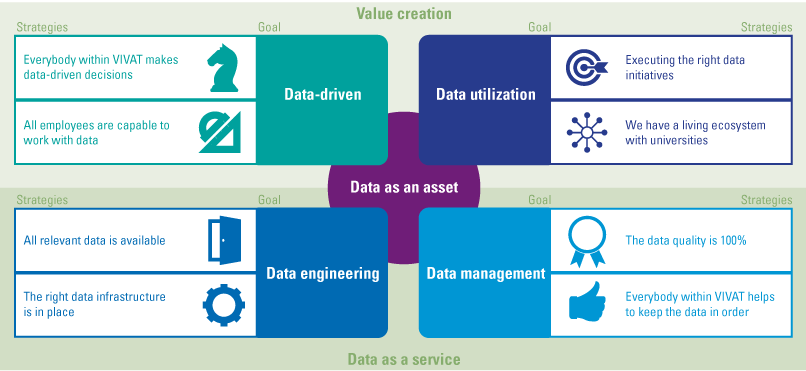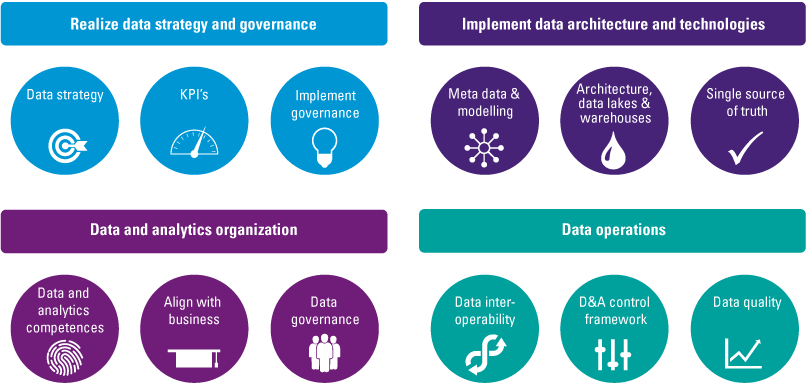It has often been stated: data is the new oil ([ECON17]). In one perspective, this may be true: the potential may be compared to the era where oil started to transform society in many ways. However, this mantra is also a bit misleading, as it suggests this potential should be easy to harvest. As easy as drilling for oil in an oil field.
The reality about data strategies in many organizations is that ideation about the benefits is the easy part; the hard work is a makeover of the organization, its systems and processes. There is no doubt that data is an important fuel for a company in the digital world. In order to really reap the benefits of data, organizations must transform into data-driven enterprises where everyone realizes how data contributes to the strategic success.
This article elaborates on the best approach to do so. It also shows the lines along which Dutch insurance company VIVAT is evolving into a data-driven organization, and the obstacles it has encountered in this journey.
How VIVAT explores data opportunities
The mission of VIVAT [VIVA18] – mother company of insurance brands Zwitserleven, Route Mobiel, Reaal and nowGo, and asset manager ACTIAM – states that: “VIVAT delivers advanced and smart solutions to our customers in a customized and simple way. VIVAT leverages state of the art technologies and excels in efficient business processes. VIVAT fosters an agile culture where our customer service improves continuously, and employees grow.” VIVAT generated € 2.9 billion in gross written premiums (GWP) in 2017, which makes VIVAT one of the top five insurance companies in the Netherlands. VIVAT has € 56,7 billion of total assets, more than 2,5 million customers and 2.500 employees. VIVAT’s strategy is built around understanding and responding to customer needs, making VIVAT future proof, and a smart application of innovation.
Data is one of the four strategic pillars of VIVAT (Customer Centricity, Digitalization, Innovation and Data), similar to many insurance companies nowadays. Data is in most cases an essential ‘raw material’ for the other strategic pillars. VIVAT fully realizes that this implies fostering data as the most important fuel of this strategy. The promise is apparent in three domains: better service to clients, improving operational excellence and a more effective and efficient way to deal with risk and compliance processes.
The board of VIVAT started the process of becoming a data-driven organization when Ron van Oijen joined VIVAT as a new CEO. He is innovation and data-minded, and sees the opportunities to strengthen VIVAT with the use of data, and started cooperating with universities and educating VIVAT people as data scientists. Charlene Xiao Wei Wu, the Chief Transformation Officer of VIVAT, brought in the knowledge from China: using data for cross-selling and the development of new propositions.
How to get started?
Next to innovation, customer focus and digitization, regulations were a strong force in the transformation towards a data-driven organization as well, such as the Solvency II regulation. VIVAT took the following route in their journey of becoming a data-driven company:
- board and management commitment to data;
- Data and Analytics maturity assessment;
- evangelize data within the organization;
- building the data organization foundation;
- define an enterprise-wide data strategy and action plan.
Before entering this journey, a few basics needed improvement. The first action was to get the basics right, in order to comply with Solvency II, and later with other regulations. The prerequisites of data and analytics were completed by setting up a logical data warehouse and implementing ready-to-use tools. Furthermore, VIVAT started initiatives in which value is created with data and analytics, to be used as compelling use cases in the organization.
Figure 1. High-level strategy data plan. [Click on the image for a larger image]
Next to these focus areas, long-term actions were defined for improving data maturity. The long-term actions will be described next.
Accelerating the data organization
After the basics in the organization were established by executing the actions as mentioned in Figure 1, VIVAT started the strategic conversations in their business units (products lines). In this acceleration phase, VIVAT recognized the following five aspects were very important.
1. Board and management commitment to data
Leadership is important to make impact in the area of data and analytics, as this involves change in many respects. It is not just a matter of hiring a bunch of data-savvy professionals. In fact, their efforts do not make any sense when other departments don’t grasp the importance of the effort of these professionals in executing the strategy. For example: customer service professionals should realize that they are the ones that can warrant reliable and up to date customer data, and thereby contribute to the long-term success. Leadership will emphasize the importance of data whenever there is an opportunity, thereby achieving top-down impact on the organization.
2. Data maturity assessment
With the help of KPMG, VIVAT executed a data maturity assessment. VIVAT was tested on four aspects of the KPMG data and analytics maturity model:
- realize data strategy and governance;
- implement data architecture and technologies;
- data and analytics organization;
- data operations.
An elaborate explanation of the KPMG data maturity model can be found in the box: “Getting the basics right: using the KPMG framework to improve data and analytics maturity”.
At the time KPMG did the data maturity assessment, VIVAT was transforming from a reactive and business-oriented data organization towards becoming proactive and applying data and analytics – not just to the separate businesses, but the entire organization. Awareness sessions on data were organized for every business in the VIVAT organization, in which the business leaders were challenged to come up with data and analytics initiatives. VIVAT is still working on improving its data and analytics maturity level, with the goal to make fact-based decisions with the use of data and analytics, and have it embedded in the organization.
3. Evangelize data within the organization
After the data maturity assessment took place, several workshops were organized with the management teams of VIVAT product line departments. Data awareness was enhanced through these workshops, with a focus on gathering ideas for the use of data in VIVAT’s product lines.
Next to that, VIVAT offered extensive education and training programs for a considerable part of the workforce (named Data Academy). The company partnered with Amsterdam Data Science (University of Amsterdam), Rotterdam School of Management, University of Groningen and Jheronimus Academy of Data Science (JADS), to considerably raise the competence level of their employees. The choice to cooperate with universities was a conscious one. In the summer of 2018, around 150 employees had participated in the Data Academy. They act as ambassadors of a data-driven culture in their working environment.
As part of the data evangelism in VIVAT, Bart Rentenaar was appointed as IT Manager Data and Marcel van de Lustgraaf as Deputy Data Governor. Van de Lustgraaf: “Originally, data was gathered to support primary processes and management information. The shift from process and management information to value generation with the use of data and analytics is taking place right now.”
In order to facilitate the business in their steps towards data-driven decision-making, supportive tooling was implemented. A few of these tools are the enterprise-wide roll-out of MS Power BI and setup of a data shop, providing each user with the relevant data they are looking for.
4. Alignment with business
Business managers are focused on improving the financial and/or commercial performance of their unit. Consequently, data initiatives should be aligned with their goals to make an impact. The good news is that business cases are plentiful. Better use of data offers excellent opportunities to optimize risk analyses and prospective information, and may result in better churn rates, opportunities to detect fraud, increase cross-selling and optimize dynamic pricing models. For instance, with the use of data and analytics, VIVAT has estimated to detect an additional € 10 million of insurance fraud each year.
There is also the phenomenon of cold feet in middle management. Although the positive effect of using data in the business is proven, not every business manager is ready to fully incorporate data in their decision-making. Business managers are in doubt if the data algorithms in use are effective, even if they have proven to do so. Another dilemma is that some initiatives may pay off in the long run, while business managers are focused on the short term. Effort is still needed to make them trust the data and their outcomes.
Before a data and analytics project is started, first the potential benefits are identified. Business and IT work together to prepare the business case and create support from management level.
To conclude, there’s also the dilemma of the chicken and the egg. Business managers may at times argue that on the one hand, data quality required to support data initiatives is not at the desired level; while on the other hand, investing in data quality – for instance by initiatives in the customer service units – is reluctantly encountered by that same business manager, as they don’t see the immediate value.
All in all, strong use cases that align with the P/L thinking in middle management and good cooperation with IT are needed to overcome these dilemmas, together with company-wide investments in data quality.
5. Define an enterprise-wide data strategy and action plan
Becoming a data-driven organization requires appropriate preparations. The most important step is to formulate a strategy to have a clear view on the perils of data – and how data and analytics contribute to the digital ambitions – what changes are needed in processes, people and systems. VIVAT defined four complementary strategic domains in this respect:
- data-driven culture (have a data-driven mindset);
- data utilization (create value with the data);
- data engineering (have the right data available);
- data management (have the correct data).
Given the importance of data and analytics, these activities were repositioned from the Finance function to a more independent position. Originally, data and analytics were in the Finance function, primarily focused on creating management information and financial statements. By setting them up more independently, data and analytics are positioned to support all business functions across VIVAT.
In order to improve the awareness among the company, the ITC (Information Technology & Change) department was renamed: Data, Technology and Change (DTC). This better reflects the broad and fundamental nature of the challenge of this shift.
Getting the basics right: using the KPMG framework to improve data and analytics maturity
Having mature data and analytics in place requires the translation of business needs into practical steps and initiatives. At the same time, it requires a solid foundation to support these steps and initiatives. In order to accomplish the solid foundation, we distinguish the following set of measures.
Figure 2. KPMG framework for improving data and analytics maturity. [Click on the image for a larger image]
1. Data strategy and governance
Data strategy and governance focuses on the development, strengthening and enhancement of data management activities within the organization. It provides the foundation and outline of best practices, policies and organizational structure regarding the long-term strategy of data, and is the basis of shared decision-making across the organization. Data strategy also aligns the overall data-related initiatives to broader organizational goals and strategic milestones. Governance crosses various levels, from strategic to operational, to ensure that ownership and accountability is in place, and standardized processes are available to achieve data value ([Staa17]). Both need to be translated into KPIs, to realize embedding and adaptation within the organization. Both strategy and governance should be sponsored by the strategic organizational level (e.g. CEO or Board of Directors). The strategy should also include a change approach: communication and awareness building activities are vital to changing the business into a data-driven organization.
2. Data architecture and technologies
A data architecture is a holistic view of the data landscape, represented through schematic diagrams on an application level or data field level. This view aims to bridge the gap between business and IT by representing business data requirements, and mapping these to technical data requirements, and visualizing applications and data flows in application blueprints and data flow diagrams. Having these available helps to justify short-term data initiatives, as these can be aligned with the overall view on data and its storage, and processing within the existing systems and applications. A dimensional analysis, where all data elements are identified and defined, builds the foundation for the Enterprise Data Model, as well as meta data management. This also encompasses master data management, which is:
- managing of shared data to meet organizational goals;
- reduce risks which are associated with data redundancy and duplication;
- ensure higher quality of data;
- reduce costs related to data integration and use of data between different systems, processes, analytics initiatives and reports.
It focuses on a timely and relevant version of the truth for each product, business partner, place, person, organization or reference data. And lastly, it consists of the tooling for data quality and data governance. These tools support the data & analytics capabilities within an organization.
3. Data and analytics organization
Having a data and analytics organization in place enables consistent management of both data (e.g. consistent data quality and definitions) and analytics (e.g. algorithm lifecycle management, but also using the data aligned with the given consent) ([Verh18]). Key is to ensure enough data capabilities, as data & analytics is still an evolving domain.
4. Data operations
Data operations consist of:
- Data quality management, i.e. the planning, implementation and control of activities that apply quality management techniques to data. It encapsulates the criteria, tools and processes required for increasing value added from data initiatives. In a structured five-step process (initiate, assess, design, cleanse, monitor) data is profiled and analyzed. From these analyses, business rules are distilled and implemented to increase data quality.
The role of good data quality management is increasing due to the growing embedding of data within organizations. To minimize the risk of poor-quality data, and be more in control of the correctness and trustworthiness of data, organizations need to plan and execute on data quality management. - Data interoperability, i.e. connecting systems and data, whilst making their interaction patterns and interdependencies transparent within source systems, data warehouses/lakes, specific data stores and reporting/calculation engines, for example by data lineage or flow diagrams. This is a requirement for e.g. data-driven regulation, such as: IFRS, GDPR and Solvency II.
Organizations implementing data & analytics should use such a framework, preferably based on international standards (e.g. DAMA DMBOK [DAMA17]), legislation, but also consider that the framework should be flexible and sustainable. As said, data & analytics is a domain still under development, so flexibility and sustainability are key. The framework that a company uses to implement data & analytics should consist of solutions, that together deliver the end-to-end view on data & analytics.
Conclusion
Becoming a data-driven organization is a massive transformative goal. Experience shows that thinking big is great and stimulating, but also that it is vital to not confront the organization with an overload of new activities. One example in the case of VIVAT is a data-driven risk analysis, used to detect possible insurance claim fraudsters within a specific insurance portfolio. The result of this analysis showed more than 150 clear-cut cases. However, the best way to achieve tangible results was to start small, by asking the professionals in charge of fraud detection, to follow up on a limited selection of potential fraudsters. This will hopefully be so successful that it will seduce the VIVAT professionals to do more. And it will also stimulate that processes become more data-oriented. VIVAT has still a long way to go, but it realizes that data is the new oil to fuel their business.
VIVAT is well on its way to becoming a more digital oriented insurer based on data. The basics are now at the desired level. The challenge is to embrace change in a controlled manner, so that VIVAT becomes a real data-driven organization. The data journey has started.
References
[DAMA17] The Global Data Management Community, The DAMA Guide to the Data Management Body of Knowledge, DAMA International, https://dama.org/content/body-knowledge, 2017.
[ECON17] The Economist, The World’s Most Valuable Resource is no Longer Oil, But Data, The Economist.com, https://www.economist.com/leaders/2017/05/06/the-worlds-most-valuable-resource-is-no-longer-oil-but-data, May 6, 2017.
[Staa17] A.J. van der Staaij and J.A.C. Tegelaar, Data management activities, Compact 2017/1, https://www.compact.nl/articles/data-management-activities/.
[Verh18] R.S. Verhoeven, M.A. Voorhout and R.F. van der Ham, Trusted analytics is more than trust in algorithms and data quality, Compact 2018/3, https://www.compact.nl/articles/trusted-analytics-is-more-than-trust-in-algorithms-and-data-quality/.
[VIVA18] VIVAT, About us, VIVAT.nl, https://vivat.nl/en/visie-en-missie, 2018.










